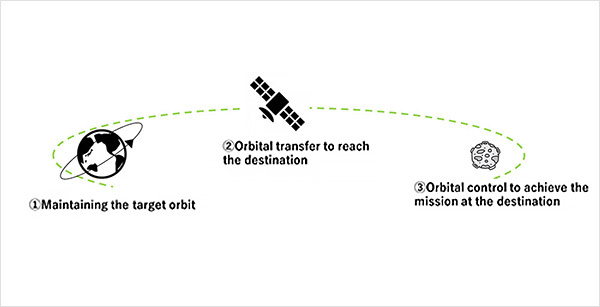Global Site
Breadcrumb navigation
Satellite orbit control
Satellite orbit control technology plays a crucial role in completing a wide array of missions. As shown in Figure 1, there are various types of satellite orbit control, including (1) maintaining target orbits for orbiting satellites, (2) orbital transfer to reach the target destination of a spacecraft, and (3) orbital control to achieve a mission at the target destination, as was used for Hayabusa and Hayabusa 2. Below is an overview of each of these.

① Maintaining target orbits for earth-orbiting satellites
The optimal orbit of an earth-orbiting satellite is chosen according to its mission. Even in space, atmospheric effects on earth-orbiting satellites cannot be ignored, with atmospheric drag causing them to gradually lose altitude. Anything that impacts a satellite’s orbit is called a disturbance, changing both orbital altitude and inclination.
To correct these orbital changes, the location of the satellite is determined by GPS or other means, the amount of orbit control required is calculated using the deviation from the targeted orbit, and the orbit is corrected at a pace of once every few days to support the continuation of the mission.
② Orbital transfers to reach the target destination
Spacecraft traveling far from Earth to observe the moon, planets in the solar system, or asteroids carry out orbital planning and perform orbital transfers to ensure they reach their destinations.
Depending on the mission of the spacecraft, various requirements need to be met (e.g., target orbit, orbit control engine capabilities, attitude conditions when performing orbit control), and a fuel-efficient orbital plan taking these requirements into consideration must be created. In addition, orbital control plans are formulated to correct the orbital deviations that occur due to engine thrust and other errors when a spacecraft is in operation.
NEC has possessed expertise and know-how in orbit control planning since the dawn of space exploration, most recently supporting orbital planning for Kaguya (moon-orbiting satellite), Akatsuki (Venus Climate Orbiter), Hayabusa (asteroid explorer), Hayabusa2 (asteroid explorer), and other spacecraft.
③ Orbital control to achieve a mission at the target destination
Hayabusa 2 achieved a high-precision touchdown with a margin of error of just one meter from its target touchdown point on Ryugu, an asteroid located approximately 300 million kilometers from Earth. The precision of this touchdown can be likened to landing on the pitcher’s mound at Hanshin Koshien Stadium (where the National High School Baseball Championship of Japan is held every year) from 20 kilometers above.
Due to the extremely high temperature near the surface of the asteroid (an altitude of approximately 50m or lower), the limited amount of time spent there (around 30 minutes), and the 40-minute round-trip communication delay for telemetry to confirm the status of the satellite and commands to direct the satellite, the asteroid explorer needed to autonomously determine its own status and confirm its safety as it descended.
Following the descent plan, NEC led the asteroid explorer to a successful touchdown by using technology for estimating the relative position of the target marker dropped on the surface of the asteroid and guiding and controlling the asteroid explorer to reach its target orbit and a sequence program function allowing it to autonomously proceed with the sequence.
February 26, 2025